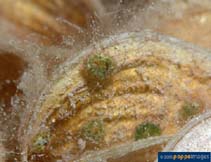Padina gymnospora (Kützing) Sonder, 1871
Funnelweed| Native range | All suitable habitat | Point map | Year 2050 |

|
| This map was computer-generated and has not yet been reviewed. |
| Padina gymnospora AquaMaps Data sources: GBIF OBIS |
Classification / Names Common names | Synonyms | CoL | ITIS | WoRMS
Phaeophyceae | Dictyotales | Dictyotaceae
Environment: milieu / climate zone / depth range / distribution range Ecology
Sessile; brackish; depth range 0 - 14 m (Ref. 83908). Tropical
Distribution Countries | FAO areas | Ecosystems | Occurrences | Introductions
Atlantic Ocean: from North Carolina, USA south to Brazil including the Gulf of Mexico, Caribbean and Bermuda, east to Salvage (Selvagens) Islands and south to Angola, including the Mediterranean (Israel), Canary, Cape Verde and Ascension Island; Indian Ocean: In the Arabian Sea south to South Africa, including the Persian Gulf, Seychelles, Madagascar and Réunion, east to India and south to Western Australia including Bay of Bengal and Andaman Sea; Pacific Ocean: from Korea to the South China Sea south to Queensland, Australia, east to Hawaiian Islands including Federated States of Micronesia, Fiji and Samoan Archipelago.
Length at first maturity / Size / Weight / Age
Maturity: Lm ? range ? - ? cm Max length : 6.5 cm TL male/unsexed; (Ref. 82093)
Short description Morphology
Thalli, attached by a small stupose rhizoidal base, are to 6.5 cm high, flabellate and composed of several lobes with inrolled margins. The superior surface (the side toward which the margin is inrolled) is slightly to moderately calcified. Thalli are olive-brown in colour. In transverse section the thallus is composed of 4-6 layers of cells in the mid-regions and up to 8-9 layers near the base. Hair rows are present on both sides of the thallus, but more conspicuous on the inferior side of the thallus. Tetrasporangia are arranged in concentric lines,
above each hair row, mainly (but not exclusively) developed on the superior surface. An evanescent indusium is present but is usually only clearly visible in very young sori. Tetrasporangia are ovoid, up to 100 μm long and 70 μm wide. Gametophytes were not observed (Ref. 82093).
Padina gymnospora is characterised by the thick thallus (up to 8 cell layers), the distribution of sporangia primarily on the superior surface of the thallus and the evanescent
indusium (Allender and Kraft 1983, Womersley 1987) (Ref. 82093).
Life cycle and mating behavior Maturity | Reproduction | Spawning | Eggs | Fecundity | Larvae
Main reference
References | Coordinator | Collaborators
Guiry, M.D. and G.M. Guiry. 2009. (Ref. 80701)
IUCN Red List Status (Ref. 130435: Version 2024-1)
CITES status (Ref. 108899)
Not Evaluated
CMS (Ref. 116361)
Not Evaluated
Threat to humans
Human uses
| FishSource |
Tools
More information
Trophic Ecology
Food items
Diet
Food consumption
Ration
Predators
Diet
Food consumption
Ration
Predators
Ecology
Population dynamics
Life cycle
Reproduction
Maturity
Fecundity
Spawning
Eggs
Egg development
Larvae
Larval dynamics
Maturity
Fecundity
Spawning
Eggs
Egg development
Larvae
Larval dynamics
Distribution
Human Related
Aquaculture profile
Stamps, Coins Misc.
Stamps, Coins Misc.
Outreach
References
Internet sources
BHL | BOLD Systems | CISTI | DiscoverLife | FAO(Publication : search) | Fishipedia | GenBank (genome, nucleotide) | GloBI | Gomexsi | Google Books | Google Scholar | Google | PubMed | AlgaeBase | Tree of Life | Wikipedia (Go, Search) | Zoological Record
Estimates based on models
Preferred temperature
(Ref. 115969): 16.1 - 29.2, mean 27.3 (based on 6652 cells).



